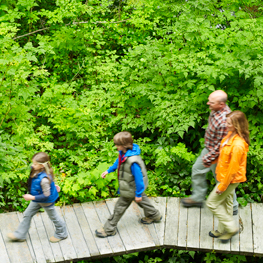
Spring and the upcoming summer are great times to explore your region’s parks and trails. But you need more than sunscreen, water and high-energy snacks to enjoy a family hike. To maximize the fun and keep the cries of, “Are we there yet?” to a minimum, try these suggestions.
Ready, set, go! Taking the time to plan your family’s next outdoor adventure can mean the difference between an okay experience and a great one.
Here are some steps you can take before you hit the trail:
Choose a trail that matches your family’s hiking skill and experience. Always pace your outing to the youngest or slowest walker in your family and build in time for breaks. If your family is new to hiking, choose a short, easy, circular trail. Once you’ve built up your family’s endurance, you can attempt longer and more challenging trails where your kids can scramble over ravines and boulders. No matter how short or long your hike is, remember to pace yourself and take frequent breaks.
Familiarize yourself with the trail before you go. Use your local library and the Internet to gather resources about the area you’ll be exploring. Determine what is the best time for your hike, based on your family’s routine, and plan around nap-time, if necessary. A good rule of thumb is to double the estimated time you think the hike will take.
Use shady trails or hike in the morning when temperatures are cooler. When the weather warms up, boardwalks along a beach or river are excellent places for a family excursion but, because they are often exposed to the elements, they can really heat up. Start out early so you can beat the heat and get on the trail before other hikers have had a chance to spook the wildlife.
Match the destination to your children’s interests. Is there a star-gazer in your family? Your local nature centre, arboretum or botanical garden may offer guided walks on full moon nights. Your budding palaeontologist might enjoy helping park archaeologists to unearth and interpret the prehistoric remains of dinosaurs, plants and early mammals. Are there boy or girl scouts in your family? Maybe there is a corn maze nearby where they can practice their orienteering skills.
Take advantage of free or low-cost hands-on exhibits, theme gardens, guided hikes and educational programs. Many city and provincial parks offer family-oriented programs on a range of topics - animal tracking, stream adventures, meadow rambles, and even geocaching, a modern-day treasure hunt where families use GPS units to find hidden containers.
Out on the Trail!
The key to kid-centered hikes is to focus on exploring and enjoying, not on a distance to cover or destination to reach. Try these ideas once your family is out on the trail:
- Lift up or roll over a log or rock and investigate what’s underneath. A magnifying glass or box is useful for holding and observing small creatures. Just remember to release any creature next to where you found it and take care not to crush any plants or insects when you replace the log or rock.
- Fill up a small bag or jar with objects you find along the way. Try to use objects with a distinct texture or smell – a pine needle, a feather, a seed pod, for example. Ask your children to close their eyes and to guess what each object is using only their sense of touch or smell.
Plant a fake item along the trail and challenge your children to spot it. Choose objects that are small and easily overlooked - like a pipe cleaner animal, artificial flower or toy insect - so that your kids develop their powers of observation.
- Stop walking, close your eyes and listen for a minute. Then invite everyone to name, describe or imitate what they heard.
Encourage children to move in different ways. They can take giant steps, small steps, skip, pretend the ground is quicksand, play red light/green light, or imitate animals.
We Made It!
The fun and learning don’t have to end when the hike does. Encourage your family to savor the moment and create memories with these activities:
- Record your hikes in a journal. Family members can take turns recording the sights, sounds and sensations of your outings. Even younger children who can’t yet read and write can glue in trail maps, make leaf rubbings, trace natural stencils or draw pictures.
- Use a real map or Google Earth and invite your children to recount the high and lows of the experience. For example, “Here’s where we walked over that log bridge.”
- Whether it’s a half-mile stroll around the neighborhood park or a day-long excursion, hiking is something the whole family can enjoy. Keep this in mind and your next hike will be ‘a walk in the park.’
Staying safe on the trail
- Familiarize yourself with the trail and plan your route before you leave home.
- Let friends or family know where you’re going and the route you’ll be using.
- Always carry a cell phone with a fully-charged battery.
- Carry identification with your name, phone number, and any important medical information.
- Stay alert, be observant about your surroundings and avoid areas where visibility is poor.
- Follow your intuition about unfamiliar areas and people you meet on the trail.
- Allow yourself enough time to complete your hike before dusk and never use trails after dark.
Justine is a contributing writer to Washington Parent. She enjoys hiking with her two sons.
Calgary’s Child Magazine © 2024 Calgary’s Child